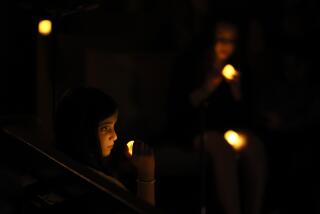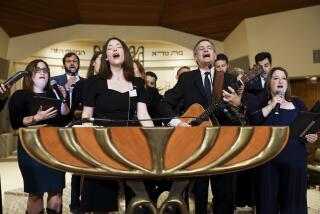Weaving a Ribbon of Unity
She sat alone Saturday in a cramped back room on a singular, fast-paced patriotic mission: measure, cut, fold, pin. In 20 seconds flat, Rachel Moran can turn a strip of red, white and blue ribbon into what is popularly being called a “Unity Pin.”
But no matter how fast this cashier at a Pasadena crafts store worked, she couldn’t keep up with the demand.
“My fingers are sore,” said the 30-year-old Altadena woman.
When Abbas Sorbi, manager of Stats Floral Supply, saw that many in attendance at the National Cathedral memorial wore red, white and blue lapel ribbons, he handed out bolts of ribbon to his workers.
The store had run out of flags, but it had plenty of ribbon.
Soon after the first basket of 50-cent pins were put out front, orders began streaming in. The Huntington Library, Pac Bell, a Bank of America branch and the local DMV all put in orders for batches of 100, 200, 500. Soon, every cashier in the store was making Unity Pins.
One bride called and ordered 300 ribbons for reception keepsakes. Susan Sullivan scooped up 80 to distribute at her nephew’s 2nd birthday party today as a small remembrance of the national heartache.
“It feels strange to have a celebration, but if each guest wears a pin, then we are remembering the pain,” she said.
All while Moran was measuring, cutting, folding and pinning. “I can’t wait to go out around town and see people wearing my ribbons.”
Firefighters Find Friends in Westwood
In New York, firefighters buried their revered chaplain, who died in the World Trade Center collapse and who was one of hundreds of members of that department to perish Tuesday.
Three thousand miles away, firefighters from Westwood’s Station 37 marked their fallen colleagues by converging on the Westwood Federal Building and pausing to reflect, helmets over their hearts.
And when passersby on busy Wilshire Boulevard spied the 10 solemn-faced firemen standing silently in a row next to the curb, some lined up alongside them. Minute after silent minute ticked by as the firefighters held their places. Before it ended, a dozen men and women had joined the firemen. They stood motionless with their hands over their hearts as other motorists--some in cars and trucks bedecked with American flags--honked and waved.
“I just want to show my support and love,” explained Todd Biederman, a Santa Monica advertising company worker who joined the firefighters’ line.
Karen Bralove, an actress and yoga instructor from West Los Angeles, lingered to thank the firefighters when the tribute ended.
“I just wanted to be a part of it,” she said. “You know how helpless we feel.”
For Reservist, Attacks Really Hit Home
There are few parts of Madeline Sullivan’s existence left untouched by Tuesday’s attack on the World Trade Center.
She is a member of the Army Reserves, serving as a paralegal with the 63rd Regional Support Command at Los Alamitos Armed Forces Reserve Center. She grew up in the Bronx. Her husband used to work as an international trader on the 84th floor of Tower 2, the second to be hit by a hijacked airliner.
She is a graduate of Manhattan’s John Jay College of Criminal Justice, a feeder school for the New York City Police and Fire departments. She does not know how many of their friends perished in the avalanche of steel and glass.
“Just yesterday I saw a colleague of mine from John Jay on TV bawling. His wife was missing,” Sullivan, 35, said during a break from her duties handling legal papers at the base.
On Saturday she found comfort in the routine of her monthly Reserve shift, filled with the usual paperwork of a headquarters unit.
But now comes the future, with its own roiling uncertainties. As a reserve, Sullivan is subject to Friday’s call-up of 35,000 reservists. Her husband, Robert, 35, is in the Army, working in a finance division--for now. He could get orders to ship out soon.
Married just two years--they began dating as fellow reservists in New York City--the couple recently began talking about having children. The attack, she said, was a “showstopper” for those plans. Now, they await orders.
For Survivalist Stores, Business Is Good
While many Americans snapped up flags to show their patriotism, others engaged in a more ominous bit of Saturday shopping. At Recon-1 Military Cutlery and Camping Supplies, gas masks were going fast.
“If you find one now, I would buy it now,” said Peter Kalaydjian, co-owner of the Tarzana survivalist store, to customers contemplating whether a mask with a filter was worth the $24.95 investment. “I have people coming in buying 30 to 50 masks at once. It’s crazy.”
Before Tuesday’s terrorist acts, Kalaydjian said his store sold about 50 gas masks a year. Since the attack, an estimated 600 masks have been purchased each day.
By 2 p.m. Saturday, Kalaydjian had already sold 600.
The masks are supposed to protect a person from biological warfare, but Kalaydjian acknowledged that some chemicals can seep through the skin and kill.
Not that it mattered to the determined shoppers. “I have to be prepared,” said Lamont Mayfield, 42, a Northridge father of three. “Otherwise I’m not being a good parent.”
Tarzana resident Mike Brown said he bought a gas mask because “I want to go down with a fight.”
Pain Hits Nation’s Farthest Reaches
Northern Vermont is a long way from New York City and Washington. It’s the kind of country where terrorism seemed, at least until last week, to be too remote a threat even to consider.
But members of the Roman Catholic Diocese of Burlington, along with Americans everywhere, were reeling. Their bishop, Kenneth A. Angell, 71, heard the news of Tuesday’s attacks and immediately thought of his younger brother, who was flying from Boston to Los Angeles that day after a family wedding in Chatham, on Cape Cod.
David Angell and his wife, Lynn, turned out to be aboard American Airlines Flight 11, the first of the planes to crash into the World Trade Center.
The diocese’s chief finance officer, Kevin Heffernan, meanwhile, knew his brother was in nearby Manhattan when the towers came tumbling down. After an agonizingly long silence, the brother finally made contact Wednesday and was unhurt, but two other relatives--a cousin and a brother-in-law--remain unaccounted for.
Both were working in the World Trade Center, where no survivors have been found.
Mosque Used by Suspects Finds Itself a Target
Three of the men who are believed to have participated in Tuesday’s terrorist attacks--Nawaq Alhamzi, Khalid Al-Midhar and Hani Hanjour--occasionally worshiped at the Abu-Bakr Mosque during their brief stay in San Diego. Now, the mosque’s association with those men has turned it into the object of hatred and violence.
On Friday and Saturday, it was shot with blue paint balls, terrifying those at prayer and forcing many to drop to the ground and take cover.
“If we can help, we are ready to help. If we know anything, we’d say,” said Saad Eldegwy, an imam at the mosque. “But we don’t know anything.”
Eldegwy said mosque leaders have circulated the names of the suspected terrorists to many of the thousands who come very week to pray, but said no one recognized their names.
Since Tuesday, the mosque has closed its day care center and primary school and has hired private security. Some neighbors have offered help and support--one, Rosalind Newman, of San Diego, dropped off a toy dove and American flag--but the anger continues to well up.
“Go home!” one woman screamed from the sidewalk. “You people don’t belong here.”
Southlanders Join in Charity Drive
It was quintessential L.A. at the Rose Bowl on Saturday: drive-through charity.
On a day when the stadium was supposed to be packed with UCLA football fans, instead a procession of cars streamed through the U-shaped entry. As they did, passengers plopped donations in buckets and baskets held out by local firefighters, police and Red Cross workers.
Friday, they collected more than $200,000 and expected the same Saturday. The “drive-thru” was hastily put together by the Red Cross, Salvation Army, KNBC-TV Channel 4 and KFWB-AM (980) radio.
“The sheer volume of the donations is amazing,” said Pasadena Fire Department Capt. Art Madison, holding out a big rubber boot to catch the cash.
Land of the . . . Oh, Wait
On weekends, Luke Spencer escapes the whirlwind of life by painting. The 45-year-old Newport Beach woman typically will set up her easel at Newport’s Back Bay or on a coastal golf course or in front of a row of towering eucalyptus trees.
Someplace majestic, bold and colorful. Someplace that will contribute to her meditation on nothing in particular.
Saturday was different.
She stood across the street from the abandoned U.S. Marine helicopter base in Tustin.
“I wanted to see some space in order to let my thoughts travel out there,” she said. “It’s a healing process for me. This day will be very beneficial.”
Spencer found herself meditating about war and religion, mortality and personal priorities.
“To be able to have a sense of security,” Spencer said. “That’s what freedom in America means to me.”
It means, she said, that people can come out to a street corner and paint what they want, what they feel, without being bothered--or persecuted, as people in so many countries are.
A white pickup pulled up. Two private security guards who patrol the closed base stepped out and asked for identification. They asked Spencer what she was doing.
Just painting, she said.
“It makes us a little nervous. Real nervous,” guard Cliff Griswold said. “It’s not a good time to do anything around the base. I’d strongly advise you to pick up your stuff and leave.”
This One’s a Keeper
Saturday morning, a customer in Van Nuys spied a large American flag at the West Marine boating accessories store. Pointing to it in the window, he asked to buy it.
No, the manager said: “It’s not for sale.”
*
Times staff writers Scott Martelle, Joe Mathews, Mike Anton and Phil Willon contributed to this report.
More to Read
Sign up for Essential California
The most important California stories and recommendations in your inbox every morning.
You may occasionally receive promotional content from the Los Angeles Times.










